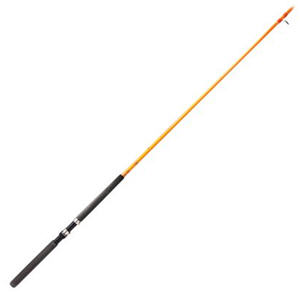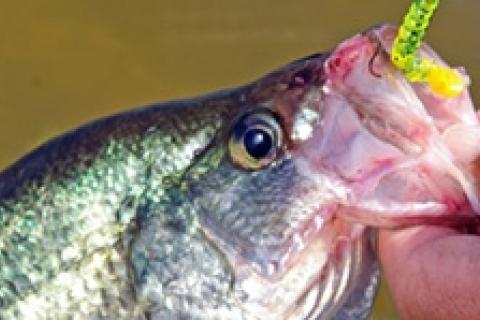
Its strike is often so delicate, it may be hooked before you know it. Seldom will one weighing much over a pound be caught. It puts up an admirable tussle on light fishing tackle, but it's not really a hard fighter. So why is the crappie such a popular gamefish?
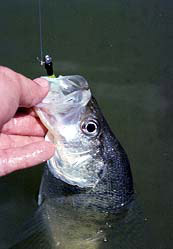 |
| Anything these sunfish lack in size, they compensate for in numbers and the ease with which they are caught. |
Crappie Fishing Year-Round
There's no single answer. Anglers laud the crappie for a combination of characteristics that make crappie fishing pure fun.
Crappie are found in hundreds of thousands of lakes and streams throughout the U.S. In-the-know anglers haul them in spring, summer, autumn, and winter. Anything these sunfish lack in size, they compensate for with sheer numbers and the ease with which they are caught.
Fancy equipment? No need. It doesn't matter if you use an old cane pole or a $200 ultralight rig. Both catch crappie.
Good eating? Absolutely. Crappie have flaky, white meat suitable for a variety of recipes. Nothing is finer than crappie fillets properly prepared and cooked.
Kids of all ages can learn how to catch crappie. Sure, trout are bedazzling jumpers. Catfish are superb dinner fare. And stripers are brutal battlers. For many anglers, however; crappie are the favorites because the certainty of some kind of fishing action is far better than promised battles that never come.
Fishing Tip: About crappie fishing during the spring spawn
Fishing Tactics for Black vs. White Crappie
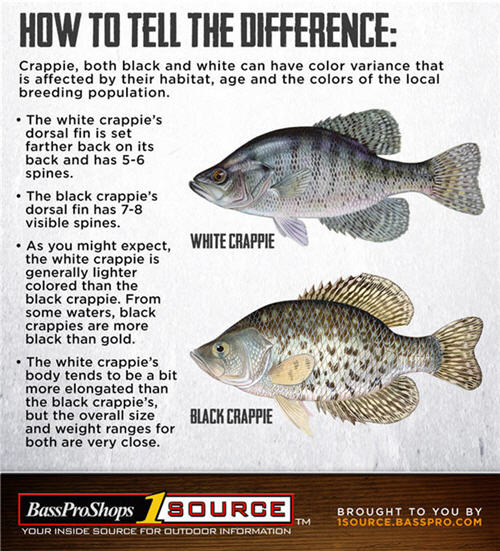
Anglers seldom bother to distinguish between the two crappie species, black and white. Fishing techniques are the same for both. Neither is a more worthy quarry than the other. But if you catch a crappie big enough for the record books, it must be positively identified as one or the other.
The most reliable method of separating the two is counting the dorsal fin spines. Black crappie normally have seven or eight; whites usually have six.
Color is not as dependable, but white crappie are paler, and dark spots on the sides are usually arranged in regular vertical bars; blacks have irregular spotting.
Black crappie prefer cool, clear lakes and large slow-moving rivers. They're slightly fussier about their environment than whites, which flourish in warmer, siltier waters. Some fishing waters have a preponderance of one or the other, but sage crappiers couldn't care less. They're after crappie, plain and simple.
Crappie have more aliases than a "most-wanted" criminal, over 50 in all. Some anglers call them specks, papermouths, white perch, or calicos. Other monikers include sac-a-lait (Cajun-French for "bag of milk"), bachelor perch, banklick, chinquapin, lamplight, speckled perch, tinmouth, and strawberry bass.
Crappie usually congregate in loose schools near woody cover. Young crappie prey heavily on insects, while baitfish comprise most of the adult's diet.
Average size depends on local conditions. While 1/2- to 1-pound crappie comprise the usual catch, prime waters can yield 'barn-doors" in the 2- to 3-pound range.
Fishing Tip: 5 Great crappie fishing destinations plus video
A Fish for All Seasons
| A top-of-the-line crappie fishing rod costs under $70. |
By applying information on seasonal preferences, you can locate prime crappie fishing areas year-round.
Summer and winter crappie form large, loose schools and usually hold near cover in 10 to 35 feet of water. In oxbows, look for fish near old river channels or the basin of the lake. Reservoir fish may concentrate in deep timber near channel breaks or humps. River crappie tend to hole up in deep backwaters. Using a sonar fish-finder makes the difficult job of locating these fish much simpler.
In spring, as the water temperature climbs into the upper 50s and low 60s, crappie move to their spawning grounds, usually in shallow, wind-protected coves with good cover. Most anglers find crappie near shoreline cover-button willows, cypress trees, blowdowns, stickups and weedbeds. Larger crappie may be farther out over shallow, main-lake humps or near channel edges adjacent to shallow flats.
During cold fronts, crappie may leave shallows for deeper water. Deep timber along channel edges or underwater humps is a favorite retreat. The more severe the front, the deeper the fish withdraw.
Locating autumn crappie is especially hard. Fish in 8-foot depths one day may move to 20 feet the next. They may hold over brushpiles in the morning and move to deep points by evening. The best advice this season is to keep moving until you find feeding fish.
Fishing Tip: Click to view of the Rookie's Guide to Spider Rigging.
Fishing Rods, Reels & Poles

Rod and Reel Combo
Virtually any rod and reel combination or pole works for catching crappie. The outfit employed depends mostly on the type waters you fish and the depth crappie are holding.
When crappie are deep or in sparse cover, ultralight rod and reel spinning or rod and reel spincast combos spooled with 4- to 10- pound line are appropriate. This combination lets you get down where the fish are and allows pinpoint casts to open cover.
Using the pole approach is usually most efficient in shallow or snag-infested waters. Pole fishing permits you to fish brushpiles, treetops and other dense cover with fewer hangups.
The trusty ol' cane pole is simple, inexpensive and efficient. But today, many dealers sell higher-quality fiberglass and graphite fishing poles. Most are telescopic for easy transportation and have built-in line-holders allowing line length to be easily adjusted. Select a length and style that's easy to handle.
The Well-Stocked Tackle Box
There are innumerable styles of tackle boxes on today's market. The one you select will depend largely on how much crappie fishing tackle you carry on each outing, the type of tackle you use and, if you're budget-conscious, the price.
If you're primarily a minnow fisherman, a small box that will accommodate a selection of hooks, bobbers, sinkers, and line may suit your needs perfectly. But if you fish both with jigs and minnows, you'll probably want something a bit more elaborate.
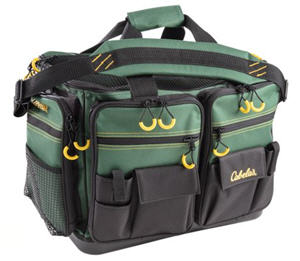
I tried a variety of tackle boxes — cloth bags, over-and-unders, tilt-trays and more before finding my favorite. Most didn't have enough tray compartments to organize my jigs. And those that had an ample number of compartments didn't have space for larger tackle like spools of line and extra reels.
I finally settled on a model that opens at the front to reveal three slide-in, slide-out, worm-proof, plastic tackle boxes, each with dividers that can be custom-fit to create up to 24 compartments. That's a total of 72 compartments, each just the right size for a couple dozen jigs and jig heads. And by purchasing more of the small slide-in boxes, I can organize additional ones to use when I change fishing tactics or fish for species other than crappie.
For example, in summer I often use small jigging spoons to catch crappie holding around deep structure. That's the only season I do much spoon fishing, so I've organized a small box full of spoons that replaces one of the jig boxes on my summer outings.
The removable lure storage boxes are also a boon when planning a trip where I'll fish for bream, catfish, bass or other species in addition to crappie. Slide out a box of jigs, slide in a box of bass lures. My tackle box also has an extra-deep top compartment for bulkier gear like stringers, line and reels.
Terminal Fishing Tackle

In the top compartment of my tackle box, I keep a smaller (4-by-8-inch) compartmented box for organizing the hooks, sinkers and bobbers I use when crappie fishing.
I prefer No. 1, 1/0 and 2/0 gold Aberdeen fishing hooks. I keep several dozen of each size, mostly thin-wire models that do the least damage to fragile minnows and will bend enough to free from snags.
Split shot are the primary type of sinkers I use. I prefer those with small "ears" for easier removal, and generally have 100 or more in sizes 8 to 3 in my box. I also keep a couple dozen trolling or bead-chain sinkers handy. These are useful when trolling or drifting for crappie.
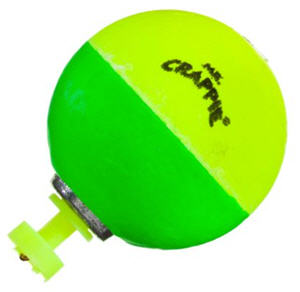
Lighted Bobbers
Fishing bobbers or crappie fishing slip floats are another important item of crappie fishing equipment. In addition to suspending the bait at the right depth and providing a visual cue that a fish has taken the bait, they also add weight so you can cast tiny lures accurately and the proper distance. I usually keep 15 to 20 in my tacklebox, including tiny, cigar-shaped floats of foam or cork, and several snap-on, plastic bobbers.
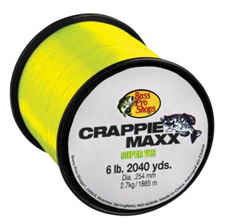
It's also wise to keep extra fishing line handy. I keep a spool of 4- to 8-pound-test for situations dictating light line and a spool of 17-pound line that I use when fishing heavy brush. I use a good premium monofilament line and consider fluorescent green or yellow line best. These colors are much more visible, which permits the detection of the lightest of strikes.
Tip: Keep a spool of 4- to 8-pound test for situations dictating light fishing line.
Jigs and Other Fishing Lures
Fishng Jigs are by far the most popular artificial for taking crappie. There are literally thousands of styles and colors available.
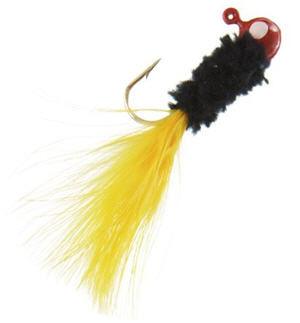
Jigs come with bodies of rubber, plastic, marabou, hair, rubber bands, floss, tinsel, chenille, and innumerable other materials. There are jigs with curly tails, ripple tails, broad tails and triple tails; jigs with lead heads, floating heads, diving heads and standing heads; jigs with spinners and without spinners; weedless jigs and those that aren't; and all this in the colors of the rainbow and every combination imaginable.
To be prepared for any situation, carry several jig styles, colors and weights. Most crappie jigs range from around 1/80th to 1/8th ounce, occasionally up to 1/4 ounce. I stock my box with four primary sizes: 1/64, 1/32, 1/16-and 1/8-ounce. Ninety percent of them are 1/32-ounce, because that's the size I find most productive in most situations. However, there are times and places where smaller or larger jigs prove more productive.
The best jig for you is the one in which you develop the most confidence. Try several varieties, and most likely, one will soon become your favorite. My personal favorites are tube and curlytail jigs, primarily because I can quickly change colors without having to cut off and re-tie the jighead. Speed and simplicity are important when trying to determine a pattern on crappie.
I also keep a variety of small safety-pin spinners in my tacklebox. These can be snapped on a jig to add extra crappie-attracting flashiness and vibration in stained or muddy water. In addition, I carry a small selection of other crappie-catching lures to use in situations where jig fishing isn't productive. Among my favorites are 1/8- to 1/4-ounce spoons, mini-crankbaits that imitate baitfish, and small in-line and horsehead spinners.
Miscellaneous Fishing Equipment
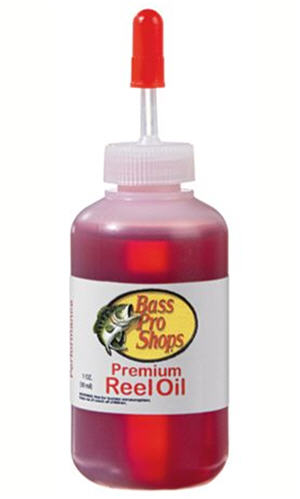
Premium Reel Oil
The remainder of the equipment in my crappie box consists of these items: an extra line-holder reel that will fit any of my jigging poles, an extra ultralight spinning reel, two chain stringers, pliers, a small reel repair tool kit and fishing reel oil, sunscreen, nail clippers (for trimming line), a digital fish scale, a fish-scaler tool, a fillet knife, and a ceramic knife sharpener. That's it. I have everything I need for most outings, and it's all together in a package ready for transport.
Of course, there's no limit to the number of interesting items you can find to enhance your crappie fishing. Here are some of additional items you may want to consider:
- Bottom contour maps of your favorite fishing lakes
- Lighted floats for night fishing
- Electric fillet knife that runs off your 12-volt boat battery
- Pocket-size rain suit
- Fishing towel
- Emergency rod tip repair kit
- Small marker buoys like the Bass Pro Shops Marker Buoys with Rack
- A portable GPS unit
- Sheer pins and other spare parts for your outboard motor
- A small flashlight, signal flares and waterproof matches for unexpected emergencies
Set Up a Fishing Pattern
Regardless of season or location, you must establish a fishing pattern to be successful. What cover are crappie using? At what depth? Are they hitting best early or late? On minnows or jigs? Yellow jigs or blue? Vary your tactics until you figure out what's best.
In spring, fish visible shoreline cover first, moving until you find crappie beds. Deep-holding summer and winter crappie are harder to locate. Fish deep cover located with sonar or troll with several lines at different depths until you find fish. "Here today, gone tomorrow" autumn crappie require shallow- and deep-water searching.
Crappie seldom strike with the gusto of bass or trout. They may simply inhale the bait with no noticeable hit. When fishing "bobberless," watch your line closely for a twitch or slackening in the line signaling a taker.
The nickname "papermouth" isn't a misnomer. Set the hook with just a gentle flick of the wrist or by simply tightening the line to avoid tearing the fragile mouth. Keep the line taut, and slowly lift and swing fish into the boat.
With the right equipment, an in-depth knowledge of the crappie's predictable habits and a little luck, you can hit the jackpot almost any place and time you fish.
A scrappy fighter. Abundant. Widespread. Easy to catch. Unexcelled table fare. Add up all the crappie's virtues, and you can only reach one conclusion. Pass the cane pole and minnows, please.
- 217242 views


